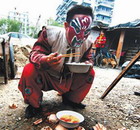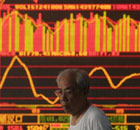Top Biz News
China's new credit rules put brakes on banks' lending binge
(Xinhua)
Updated: 2010-02-22 11:18
 |
Large Medium Small |
BEIJING: With Chinese banks' record new lending in 2009 igniting fears about asset bubbles and bad loan, the banking regulator's latest rules aim to bring financial risk under control.
The new directives order banks to focus on loan quality control, rather than quantity restriction, and aim to make loans flow to the real economy -- rather than the property and stock markets, which are susceptible to asset bubble formation.
Analysts say the directives are a smart way to handle the policy dilemma the central bank faced: with inflationary pressures growing after increased money supply, how can monetary policy be tightened without hurting the fragile economic recovery?
The China Banking Regulatory Commission (CBRC) issued new regulations on Saturday evening telling banks to set lending quotas after "prudent calculation" of borrowers' "actual demand".
It also reiterated working capital should not finance fixed-asset investment and equity stakes. The new rules also ask lenders to give funds directly to the end user declared by the borrower, instead of directly giving it to the debtor, in an effort to ensure loans are used for their declared purpose.
Execution of the directives will help banks exit the "credit stimulus spree", as they pay more attention to risk control. The directives are crucial for the banks' sustainable expansion, said Yu Xiaoyi, analyst with Guangfa Securities.
Loose oversight and easy monetary policy have led to many banks developing the bad habit of being excited about loan extension but indifferent to the tracking of loan use, which can result in credit appropriation, an unnamed insider told Xinhua.
That allowed many Chinese enterprises to borrow much more than they needed in order to speculate with various types of investment, even though they had ample funds on hand for their routine business operations.
In support of the government's 4-trillion yuan stimulus package, Chinese banks lent an unprecedented 9.6 trillion yuan in 2009, nearly half of 2009 gross domestic product.
Researchers said that large amounts of the borrowed funds went into property and stock market speculation, further pushing up soaring house prices and further inflating asset bubbles.
According to official data released by CBRC, some regions reported two to three percent of funds were misappropriated.
Wang Kejin, an official with the Supervision Rules and Regulation Department of CBRC, told Xinhua "the current working capital and individual loans exceeded real market demand,"
The inadequate monitoring of loan use demands improvement, otherwise creditors will suffer losses and systemic risks will build, the CBRC said in a statement on its website.
"Our purpose was to prevent it happening," the statement said.
Ba Shusong, a researcher with the Development Research Center of the State Council, China's cabinet, said the new rules will further strengthen credit risk controls and put a "brake" on lending and keep the financial system in good health,
Guo Tianyong, a professor with the Central University of Finance and Economics, said the new directive will prevent systemic risk after the rapid expansion in credit.
CBRC chairman Liu Mingkang said on Jan 27 the Chinese government is aiming to restrict credit supply to 7.5 trillion yuan ($1.1 trillion) in 2010.
Analysts expect short-term loans to fall significantly on account of tougher lending requirements that prevent businesses using new loans to repay old credit, a phenomena rampant when bill financing with 180-day maturity comprised nearly half of new loans in the first quarter of 2009.
To soak up the excess liquidity on the heels of lending spree, China has raised the deposit reserve requirement ratio (RRR) twice this year, after holding it steady for over a year, to handle the "comparatively loose liquidity" while keeping the "moderately easy" monetary policy unchanged.
Jing Ulrich, Chairman of China Equities and Commodities at JP Morgan Chase, estimated China's new lending would fall 17 percent this year as the government takes steps to prevent inflation.
"While lending support for real economic activity is expected to continue, banks are likely to be more vigilant on shorter term credit facilities, given the regulator's anxiety over asset bubbles and capital adequacy ratios," she said.













